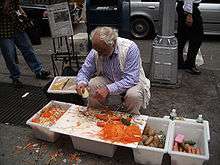Product demonstration
In marketing, a product demonstration (or "demo" for short) is a promotion where a product is demonstrated to potential customers.[1] The goal of such a demonstration is to introduce customers to the product in hopes of getting them to purchase that item.
Products offered as samples during these demonstrations may include new products, new versions of existing products or products that have been recently introduced to a new commercial marketplace.
In-store
In-store demonstrations are usually performed at large retail locations, such as supermarkets, department or discount stores, or in shopping malls.[1] The products that are promoted at in-store demonstrations may be food and beverages, food preparation equipment, housekeeping products, personal care items, or occasionally other types of goods. The samples that are distributed may either be in readymade packets pre-assembled for the demonstration, or are prepared on site by the demonstrator. Some demonstrations involve the distribution of prepared food, requiring the demonstrator to bring equipment such as a microwave oven or hot plate to the location.
Often, coupons for the product are distributed as part of the demonstration. Some demonstrations consist of coupon distribution only.
Demonstrators may be employees of the store where the demonstration is being performed, employees or the manufacturer of the product, or independent contractors who work for a temp agency. Most are not trained to seek out customers likely to buy the product.[2]
Advantages
In-store demonstrations allow potential customers to touch or taste a product before they buy.[3]
History
By the mid-1950s Ron Popeil states that "I was working in the Woolworth's store in Chicago selling the Chop-O-Matic, standing eight or 10 hours a day. I would do six demonstrations an hour. My vocal cords were so strained that I wouldn't want to talk to anybody when the day was over." [4] The concept of the in-store demonstration started to boom in the 1980s.[5]
Home
Door-to-door, and by-appointment salespeople demonstrate such products as Tupperware, encyclopedias, vacuums, and carpet stain removers.
Trade show
Prototypes are often demonstrated in trade shows, and are called "tech demos".
Fairs
Product demonstrations have been a staple of state fairs for many years.
Television
The first product demonstration in a format that would later be called an infomercial is attributed to a 1949 demonstration of the Vitamix blender.[6]
Roadside
Many countries around the world do not place legal restrictions on outdoor product marketing and demonstrations. Salespeople set up temporary sites to demonstrate their wares in order to attract sales.
China
A wide variety of products are demonstrated roadside throughout the China. Such products include frying pans, induction cookers, rubber gloves, vegetable peelers and slicers, stain removers, and knives.
Video
Included with a purchase, a video on a DVD disc may be provided demonstrating the product's use.
Video product demonstrations can also be found on the Internet at the homepages of companies or on web hosting sites such as YouTube. One notable example is the viral video Will It Blend? demonstrating Blendtec blenders.
Music Equipment
Product demonstration videos have become increasingly important for the sale of music equipment. With the increase of online shopping, there are fewer opportunities to try a product prior to purchase. This has a particular problem for music equipment which, unlike other technology, the quality of the sound produced may come down to a more personal preference and may not be as closely related to the specifications of a particular product.
YouTube is one of the main hosts of music equipment videos, and channels may be run by retailers, publishers, musicians or even manufacturers themselves.[8] With decreases in music sales, demonstration videos have become an additional source of revenue for full-time musicians, with artists such as Rob Chapman (musician, 1975) having over 400,000 subscribers.
See also
- Hawker (trade)
- Freebie marketing
- Wine tasting
References
- "in-store demonstration: Definition from Answers.com". answers.com. Retrieved 2015-05-12.
- Lempert, P. (2002). Being the Shopper: Understanding the Buyer's Choice. Wiley. p. 193. ISBN 9780471263739. Retrieved 2015-05-12.
- Debelak, D. (2005). Bringing Your Product to Market...In Less Than a Year: Fast-Track Approaches to Cashing in on Your Great Idea. Wiley. p. 326. ISBN 9780471738701. Retrieved 2015-05-12.
- Wehrum, Kasey. "How I Did It: Ron Popeil, Ronco". Inc.com. Retrieved 10 August 2015.
- "The Milwaukee Sentinel - Google News Archive Search". news.google.com. Retrieved 2015-05-12.
- Vitamix blender infomercial on YouTube https://www.youtube.com/watch?v=pJ0uz6YdTcM
- Good, Dan. "Selling schlock on the Boardwalk". Press of Atlantic City. Retrieved 5 August 2015.
- "List of YouTube Music Equipment Channels".

